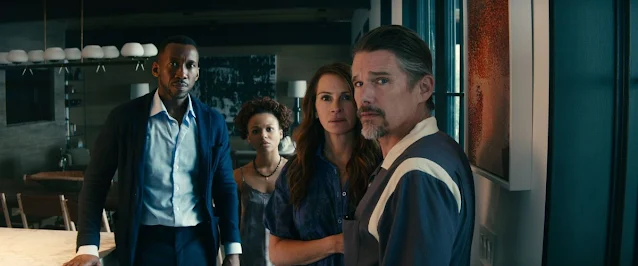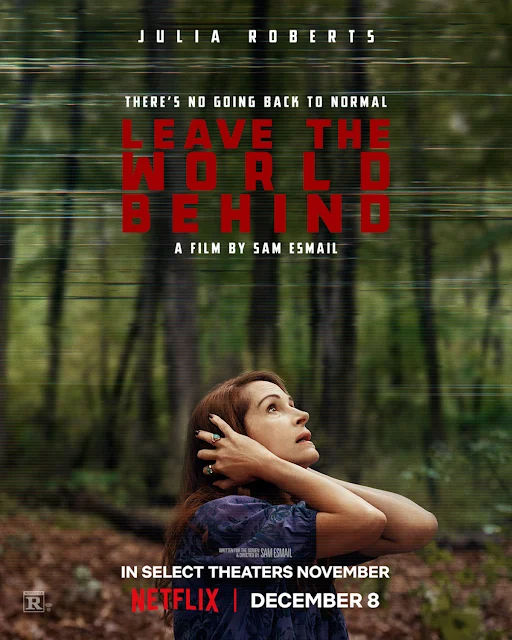Leave the World Behind," a film by Netflix under the direction of Sam Esmail (Comet, Mr Robot) presents a riveting narrative that navigates the complexities of an apocalyptic setting, racial tensions, and the intricacies of human relationships.
The film's portrayal of two families, the Sandfords and the Scotts, in an uneasy cohabitation, sets the stage for a deep exploration of societal and personal conflicts.
Themes of Leave the World Behind
"Leave the World Behind" delves into a multitude of themes, with a particular focus on the fragility of societal structures and the inherent complexities of human relationships in times of crisis.
One of the central themes is the unpredictability of human behavior under stress, as exemplified by the interactions between the Sandford and Scott families. These interactions are a microcosm of larger societal dynamics, reflecting how crisis can either bridge or widen existing social and racial divides. The film explores how individuals react differently to the same situation – some with fear, others with denial, and yet others with a sense of pragmatism.
This diverse range of responses serves as a commentary on the human condition, showcasing the varied ways people cope with uncertainty and chaos. Additionally, the film subtly addresses racial tensions, not through overt confrontations, but through nuanced interactions and underlying biases that come to the fore in stressful situations. This aspect of the film is particularly resonant, as it mirrors real-world issues of racial dynamics and prejudice as the families come to terms with each other's presence.
Another significant theme in "Leave the World Behind" is the existential dread and vulnerability that comes with facing an apocalyptic scenario. The film masterfully captures the sense of unease and foreboding that permeates a world on the brink of collapse. This is not just a physical apocalypse but also a psychological one, as characters grapple with the loss of normalcy and the breakdown of societal norms.
The theme of existential dread is further amplified by the film's setting and visual storytelling, where the normal is juxtaposed with the surreal, creating a sense of disorientation and unease. The characters' struggle to maintain a semblance of normality in the face of looming disaster highlights the human tendency to seek comfort in the familiar, even when the world is changing irrevocably around them.
This theme resonates deeply in a contemporary context, where global challenges often leave individuals feeling powerless and adrift.
Character Dynamics and Racial Undertones
Julia Roberts, in her role as Amanda Sandford, delivers a performance marked by intensity and complexity. Her character oscillates between being self-centered and vulnerable, revealing layers of human emotion often obscured in apocalyptic narratives.
The racial dynamics, particularly highlighted in her interactions with the Scott family and Ruth, whose mother is missing, are handled with subtlety.
This nuanced approach to addressing racial tensions is commendable but also leaves certain areas underexplored, such as the personalities of Amanda's children, which are depicted in relatively lighter tones.
Directorial Style and Visual Storytelling
Sam Esmail's directorial style is a standout feature of "Leave the World Behind." Known for his unique visual flair and what I'm gonna call 'character snark', Esmail employs dramatic camera movements and unconventional shot compositions to enhance the storytelling which reminded me of David Fincher's The Panic Room at one point.
The use of long pans, crane shots, and reoriented frames adds a dynamic quality to the film, capturing the chaos of the apocalyptic setting. These visual elements effectively convey the disarray and desolation of a world in crisis, from scenes of inoperative planes to the grim imagery of dead bodies washing ashore.
Narrative Structure and Emotional Impact
The film, however, confronts challenges in its narrative structure.
The absence of a significant onscreen death, a common trope in disaster films to heighten emotional stakes, results in a certain detachment.
The storytelling, spanning 141 minutes, intermittently loses momentum, not fully exploiting opportunities for deeper emotional engagement. This narrative pacing issue detracts from the film's ability to connect with the audience on an emotional level, despite its thematic depth and strong performances.
Performance Highlights
In "Leave the World Behind," the performances stand as a testament to the film's emotional depth and narrative complexity. Julia Roberts, portraying Amanda Sandford, delivers a nuanced and powerful performance, skillfully navigating her character's multifaceted nature, from self-centeredness to vulnerability, while subtly handling the racial dynamics in her interactions.Collectively, these performances not only elevate the film's apocalyptic narrative but also transform it into a profound exploration of human nature and societal dynamics, making it a significant work in character-driven cinema.
A lot of people will bemoan the 'soft ending'- however this film was not a disaster movie but a mediation on the human condition.
The ending of "Leave the World Behind" is thus intentionally ambiguous, leaving much up to the audience's interpretation.
The film concludes with Rose finding a survivalist bunker and taking comfort in finally being able to watch the series "Friends," while other characters, like Clay, G.H., and Archie, face their own unresolved challenges. The city skyline is seen burning, indicating widespread disaster, but the movie does not provide explicit explanations for these events, reflecting a similar ambiguity to the book's ending.
In conclusion, "Leave the World Behind" stands as a compelling, albeit flawed, exploration of human nature and societal issues set against an apocalyptic backdrop. Its strengths lie in its unique directorial style and the complexity of its characters, though it grapples with maintaining emotional depth and narrative cohesiveness throughout its extensive runtime.












